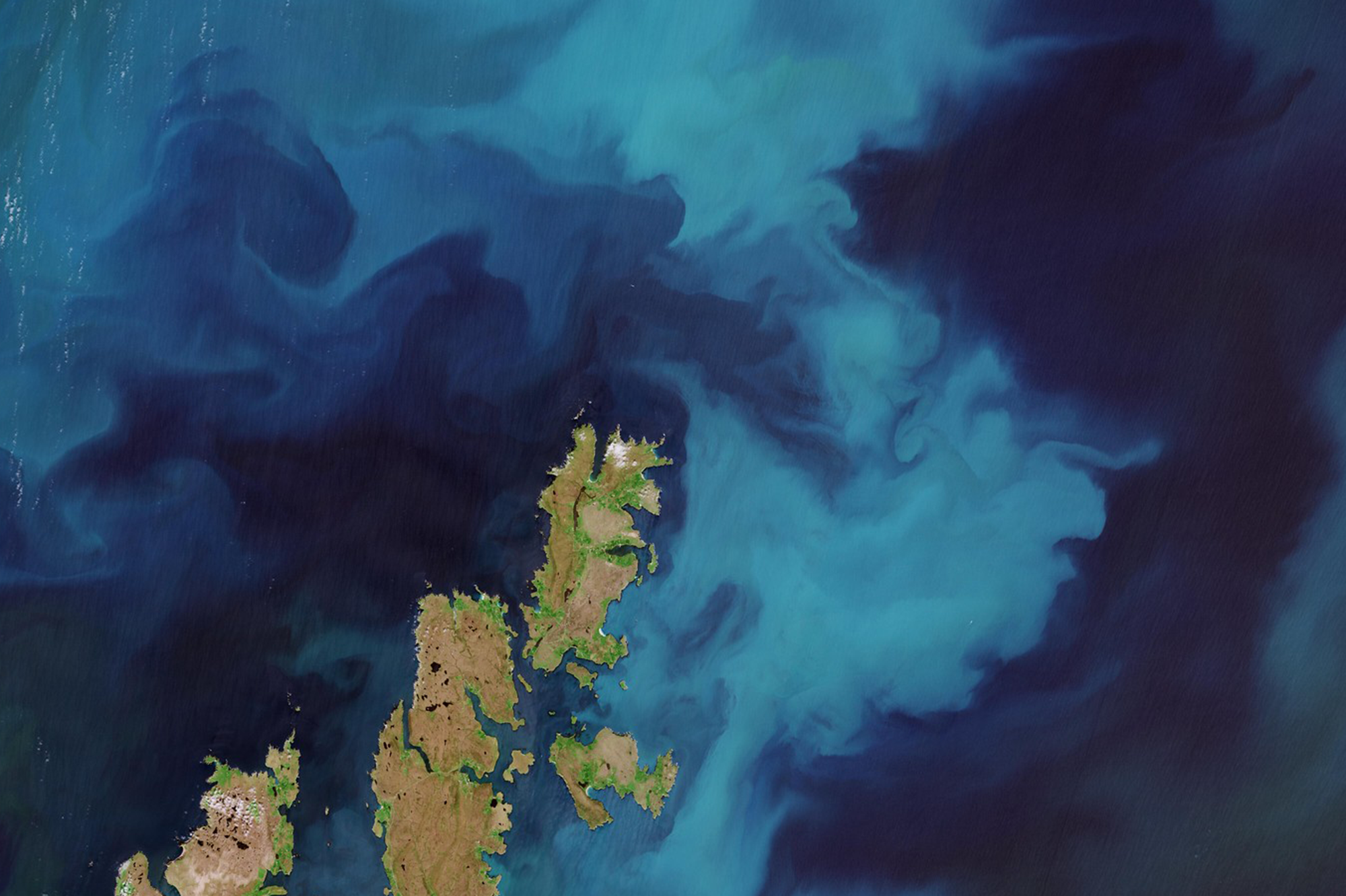Story
Unusual blooms in Scottish waters
28 September 2023
New study examines the conditions that led to two unusual coccolithophore blooms in Scottish waters during the summer of 2021. Using satellite data and expert analysis, the study suggests that cold weather and easterly winds were the likely reasons.

Coccolithophore bloom | European Space Agency
.png?width=200&height=200) Coccolithophores are single-celled, calcified phytoplankton that usually measure 5–100 micrometres (0.005 – 0.10mm) in diameter. Although tiny, they are ecologically important and play a vital role in the Earth’s carbon cycle, as well as being a key component of many marine food webs.
Coccolithophores are single-celled, calcified phytoplankton that usually measure 5–100 micrometres (0.005 – 0.10mm) in diameter. Although tiny, they are ecologically important and play a vital role in the Earth’s carbon cycle, as well as being a key component of many marine food webs.In an event of high nutrient availability during a period of stable waters and warming temperatures, certain species of coccolithophore can ‘bloom’, in which they rapidly increase in number until a critical mass is reached, at which point they shed their calcified exoskeleton ‘plates’, known as coccoliths. When the coccoliths are shed, the bloom can be seen by the human eye and satellites, as they turn large areas of the sea a milky turquoise colour.
But this stunning visual effect is not the only consequence of coccolith shedding. It is estimated that 145 kilograms of carbon is used to build every tonne of coccoliths so when the coccoliths are shed, some of that carbon sinks to the seafloor where it is stored away from the atmosphere.
Coccolithophore blooms themselves are not unusual in UK waters and are common in spring and early summer in the North Atlantic, and also occur in some years in the northern North Sea and the western English Channel.
The unusual nature of the two blooms in question was their location; inshore to the east of the Shetland Islands and in the Clyde Sea on the west coast, which has not seen such a striking occurrence for many years. Colleagues of one of this paper’s authors recall no such event since 1983, when they remember sampling turquoise waters and coccolithophores in the sea-lochs of the Firth of Clyde.
For the Shetland bloom, it was oddly close to the shore and an examination of satellite imagery from 1998 – 2020 found no other instance where a bloom intruded among the islands and bays on the eastern side of Shetland.
The study team, involving scientists from the Met Office, Marine Scotland, Plymouth Marine Laboratory, Centre for Environment, Fisheries and Aquaculture Science and the Scottish Association for Marine Science, were puzzled so embarked on a quest to look for unusual environmental conditions in 2021 that might have allowed these blooms to thrive at these unexpected locations.
They found that for the Clyde Sea region, April 2021 was the coldest April of the last 30 years and they hypothesised that it was this cold weather that restricted the usual spring bloom of diatoms, a photosynthesising transparent algae. A restricted spring bloom would mean higher than usual concentrations of nutrients in the summer and might also mean reduced numbers of grazers. These factors would provide ideal conditions for coccolithophores to flourish as temperatures and sunlight increase.
For Shetland, they examined daily particle trajectories for 2021 to understand how the bloom appeared so close inshore. Particles generally moved south, down the eastern side of Shetland during the second half of June but in late June and early July there was a brief period of easterly winds and the particles were driven towards the coast. Brief easterlies are not unusual but these coincided with coccolithophore-laden water near to the coast so suggests that coincidences of timing and weather in 2021 created the phenomenon of a visible coccolithophore bloom on the eastern Shetland coast.
Coocolithophores are not normally harmful to humans or other marine life and can be a welcome source of food for marine animals during spells of low nutrients that can limit the levels of other phytoplankton species on the menu. However, any significant environmental change can have cascading impacts up and down the food web so if these blooms are occurring in unexpected places, it is prudent to find out why.
Dr Peter Miller, co-author of the paper and Marine Earth Observation Scientist at Plymouth Marine laboratory, commented:
“Phytoplankton, which include coccolithophores, are of special interest in the waters around Scotland, where aquaculture and fishing are major industries. However changing weather patterns have the potential to influence the occurrence of unusual phytoplankton blooms in coastal waters so it is important that we try to understand these changes and how they impact the marine environment and the industries it supports.”
Dr Susan Kay, another co-author on the paper and Numerical Modeller at Plymouth Marine Laboratory, added:
“This paper has shown how use of satellite data and model reanalysis can help to meet the challenge of assessing major events in UK waters. However, we could be more confident in our findings if we had more information about environmental conditions and more complete data on other salient factors, such as river inputs. Widespread routine monitoring of nutrient levels and phytoplankton components would help greatly in understanding future blooms and inform the development of any required adaptation measures.”
Related information
Full paper publish in the Copernicus State of the Planet report: Renshaw, R., Bresnan, E., Kay, S., McEwan, R., Miller, P.I. & Tett, P. (2023) Unusual coccolithophore blooms in Scottish waters. State of the Planet, 1-osr7: 7th edition of the Copernicus Ocean State Report (OSR7), 13. doi: 10.5194/sp-1-osr7-13-2023